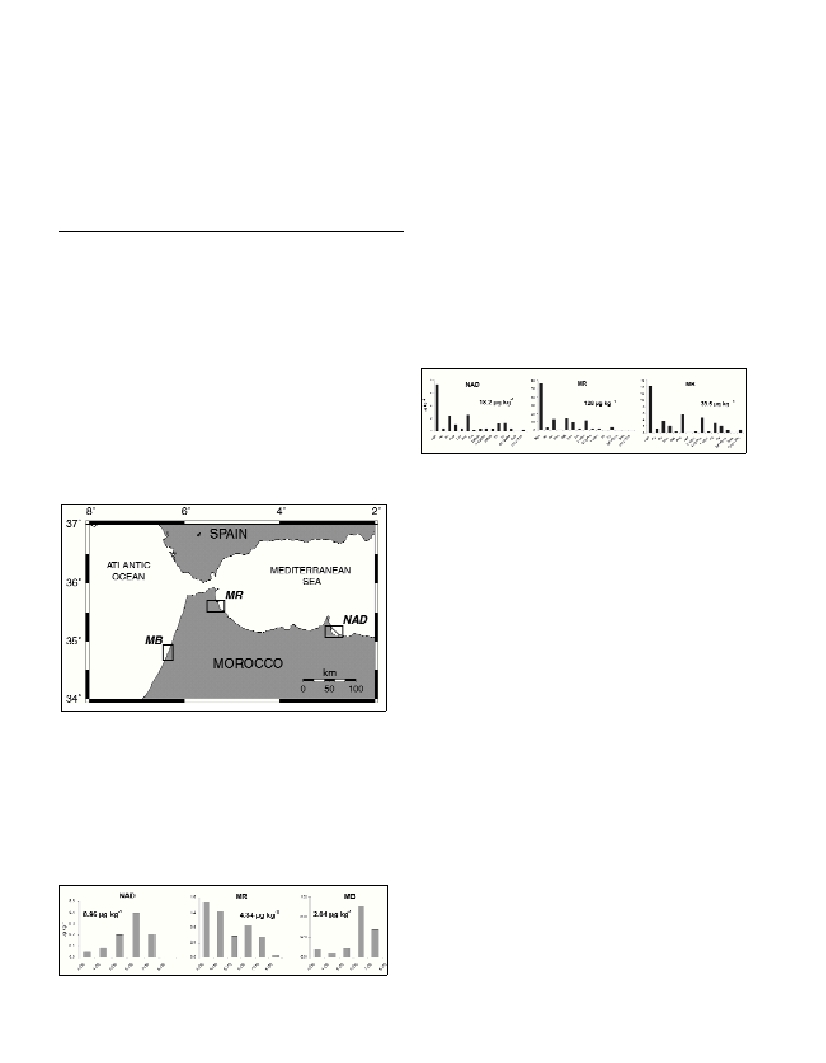Rapp. Comm. int. Mer Médit., 37,2004
27
PCBsAND PAHsIN MOROCCAN LAGOON AND RIVER SEDIMENTS
B. El Moumni
1*
, R. Piazza
2
, L.G. Bellucci
3
, M. Hamani
1
, M. Frignani
3
1
Université Abdelmaleck Essaadi, Dept. of Earth Sciences and Oceanology, Tangier, Morocco
2
Dipartimento di Scienze Ambientali, Universitŕ Cŕ Foscari, Venezia, Italy
3
Istituto di Scienze Marine, Sezione di Geologia Marina, CNR, Bologna, Italy
*bmoumni@yahoo.fr
Abstract
Three surficial sediments from the Martil River and the lagoons of Nador and Moulay Bousselham were analysed for polychlorinated
biphenyls (PCBs) and polycyclic aromatic hydrocarbons (PAHs). The level of contamination was low in all samples, with higher values
in the river sediments (4,8 and 124 µg kg
-1
for PCBs and PAHs, respectively).
Keywords: PCBs, PAHs, sediments, Moroccan lagoons, Martil River
Introduction
Sediments, for their characteristics, can be considered as an archive
of information on past and present environmental processes. In
particular, the analysis of surficial sediments taken from rivers,
lagoons and coastal areas can shed light on present contamination
levels. Because of this we sampled sediments from several sites
representing two areas of great environmental value, such as the
lagoons of Nador and Moulay Bousselham, and the Martil River that
?ows through the industrial town of Tétouan.
Materials and Methods
A short sediment core was taken from a salt marsh in the Lagoon
of Nador (north-eastern Morocco) in September 2000. Furthermore,
in October 2001 other samples were collected along the terminal tract
of the Martil River, whereas the Moulay Bousselham Lagoon was
sampled in November 2002. The location of sampling sites is shown
in Fig. 1. The concentrations of PCBs and PAHs were determined by
GC-MS [1].
Fig. 1. Location of the study areas: NAD: Nador Lagoon; MR: Martil
River; MB: Moulay Bousselham Lagoon.
Results and discussion
Total contents and relative abundances of PCB homologues and
PAH congeners are shown in Figs. 2 and 3. All concentrations are low
compared to polluted areas [2,3,4], even if the values in river
sediments are significantly higher than in the lagoon environments,
which can be considered uncontaminated. While the composition of
PAHs shows only minor differences at the three sites, the relative
abundances of PCBs in the Martil River is significantly different from
those characteristic of the other two locations. In particular, in the
Martil River the light PCB fraction (mainly the 3-CB and 4-CB) is
rather important, whereas the high molecular weight PCBs are less
represented. The clear differences among the three profiles account
for the contribution of different sources. Among PAHs, the most
abundant is naphthalene, followed by phenanthrene and acenaph-
thene. Unfortunately, the information is not yet sufficient to decide
whether the prevailing source is oil or combustion.
Fig. 3. Concentrations (µg kg
-1
) of total PAHs and congeners in surficial
sediments.
The inventories of
137
Cs calculated for lagoon cores suggest that
Nador and Moulay Bousselham sediments are mostly subject to
atmospheric contributions.
References
1-Piazza R., Manodori L., Gambaro A., Moret I., Frignani M., Bellucci
L.G., and Albertazzi S., 2003. Polychlorinated biphenyls in sediment cores
from the northern Venice Lagoon. Organohaogen. Compounds, 62: 197-
200.
2-Frignani M., Bellucci L.G., Carraro C., Raccanelli S., 2001.
Polychlorinated biphenyls in sediments of the Venice Lagoon.
Chemosphere, 43: 567-575.
3-Frignani M., Bellucci L.G., Favotto M., Albertazzi S., 2003. Polycyclic
aromatic hydrocarbons in sediments of the Venice Lagoon. Hydrobiologia,
494: 283-290.
4-Bertolotto R.M., Ghioni F., Frignani M., Alvarado-Aguilar D., Bellucci
L.G., Cuneo C., Picca M.R. Gollo E., 2003. Polycyclic aromatic hydro-
carbons in surficial coastal sediments of the Ligurian Sea. Mar. Poll. Bull.,
46: 903-917.
Fig. 2. Concentrations (µg kg
-1
) of total PCBs and homologues in surficial
sediments.

